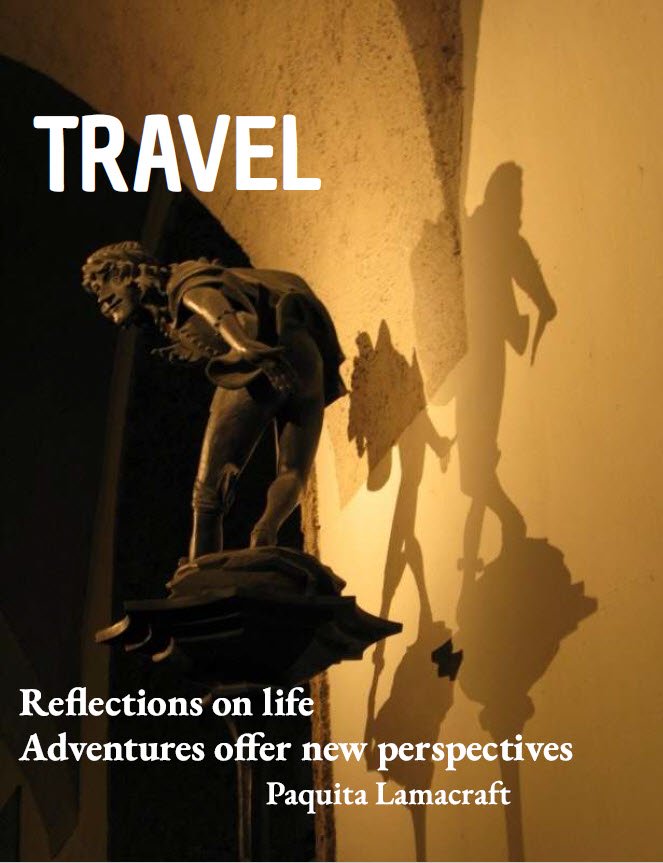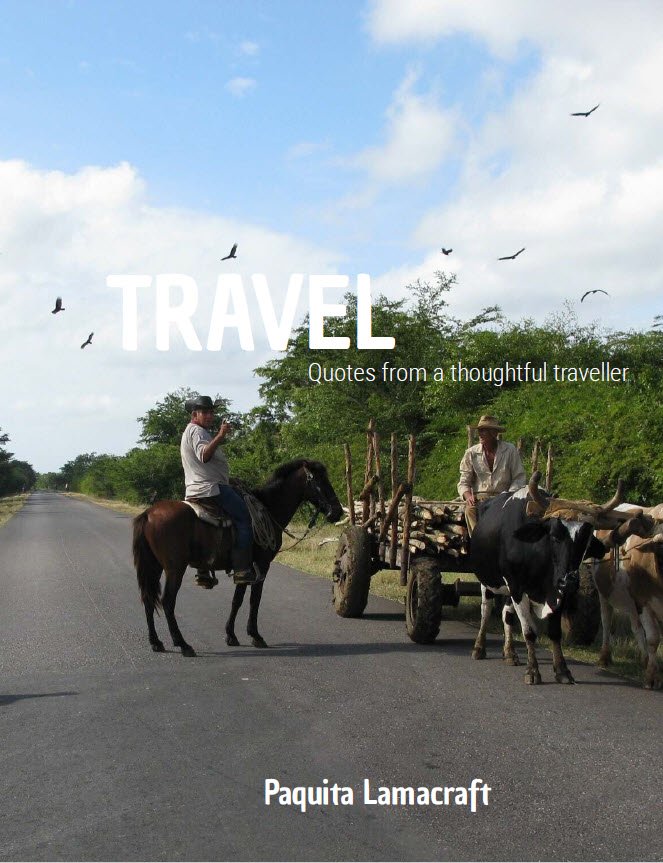Children’s Carnival Parade
The Childrens’ Carnival parade in Mainz is a much anticipated delight of innovative costuming by schools and childrens’ societies, watched by other children in costume – grown up ‘children’ as well as small ones!
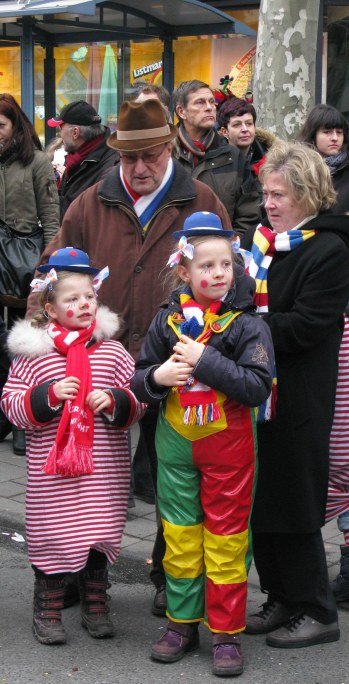
On the Saturday prior to the big parade of the 5th season (Carnival – or Fastnacht) of the Mainz calendar is an event that shouldn’t be missed if one has the opportunity.
This is the Fastnachts Kinderumzug - the Carnival Season Childrens’ Parade. It is set in the historic setting of a city that traces its roots back beyond the Romans.
The city centre architecture makes a great backdrop as families head for the parade route.
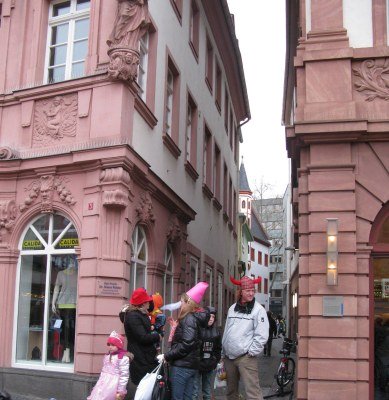
Carnival Posse of Mainz Children's Carnival Parade
No longer living in walking distance, I was driving into town when the carnival 'Posse' swung in ahead of me, passing cars tooting their horns in encouragement.
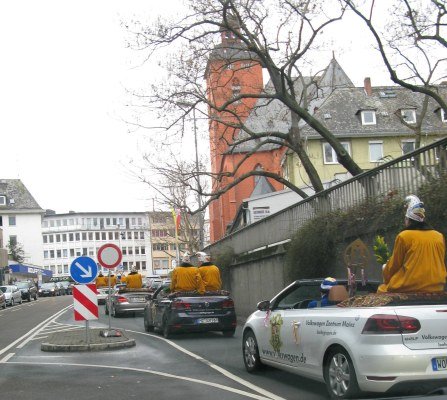
The 'Posse' sits outside the theatre in the centre of town on the reviewing stands.
Here, the proclamations for the Children's Parade are read out in verse (as with everything else during Mainz’s 5th Season).
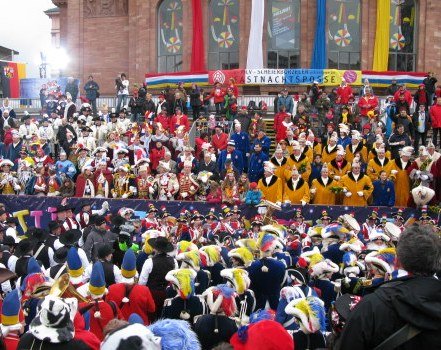
The scene is a mass of colour and feathers…
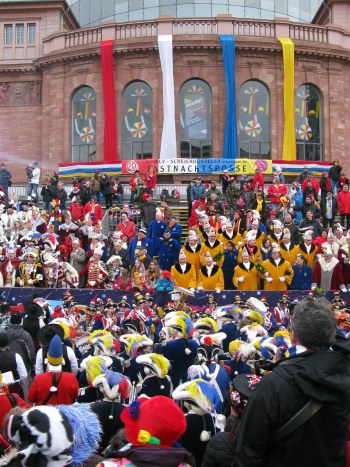
…balanced by the traditional black and white of the Master Carpenters, seen here on the left .
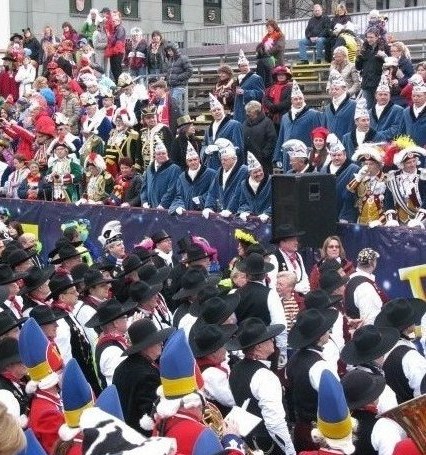
Johannes Gutenberg University in Mainz
The white building in the background is one of the original buildings of the Johannes Gutenberg University .
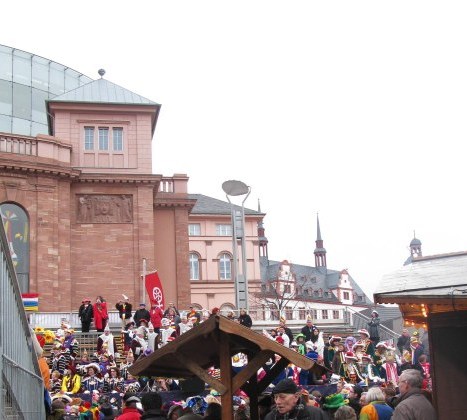
The University was formed in 1477 just before the death of its namesake, Gutenberg, inventor of the printing press.
Closed by Napoleon in the 1800s, it was ironically not re-opened until the occupation by French forces after World War II.
Now it is a well respected research institute with more than 36,000 students from 130 nations.
The Gitenburg heritage in the children's Carnival parade in Mainz
The Gutenberg University tagline is:
The Gutenberg Spirit:
Moving Minds – Crossing Boundaries
The official website of the University expands this by explaining:
The University remains true to the example of Johannes Gutenberg: furthering and implementing innovative ideas, using knowledge to improve the living conditions of people and their access to education and science, and encouraging people to overcome anticipated, as well as actual boundaries, wherever possible.
Mainz is the capital of the German state of Rhineland-Palatinate, which celebrated 2011 as a “City of Science” – reflecting its long history of research and innovation.
In 2012 the Mainz Children’s Carnival Parade was a celebration of the impact and legacy of the printing press, and it being a home town invention.
The Gutenberg Museum in Mainz is a pilgrimage stop for all who are fascinated with the legacy of the printed word, with displays from illuminated script to the Gutenberg Bible.
In the Children's Carival Parade, a larger than life Gutenberg was trailed like the Pied Piper by little people safely intact in holes within his flowing train.
Roughly translated, the banner says that Gutenberg freed the word from the control of the cloister and it is the responsibility of his grandchildren that they keep words free in their time also.
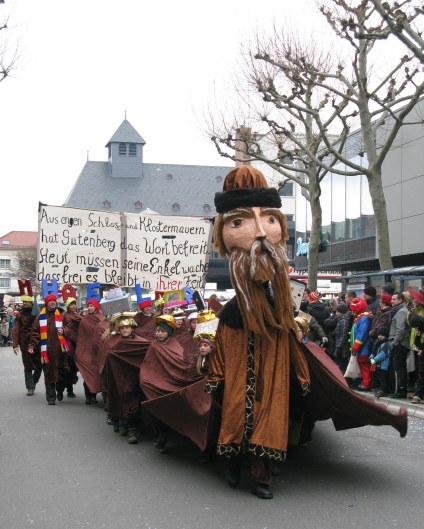
Miniature Gutenbergs followed.
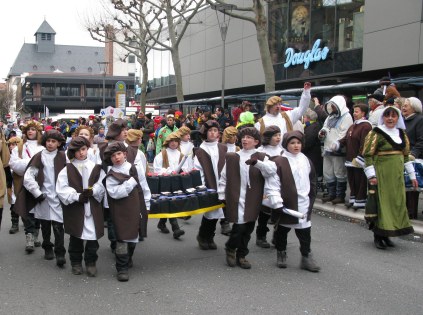
The children's carnival parade had a brace of 'Newspaper ducks' (in German ducks are ‘Enten’)…
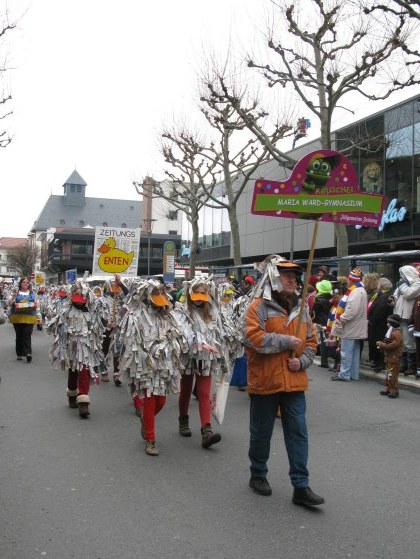
Within this brace of feathered creatures the chicks were held securely between fabric boundaries so they didn’t wander off.
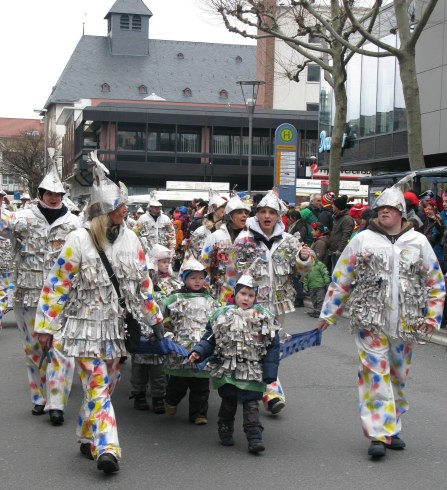
They paraded behind a banner that said that if they learn their ABCs, they will be able to read the newspaper all on their own!
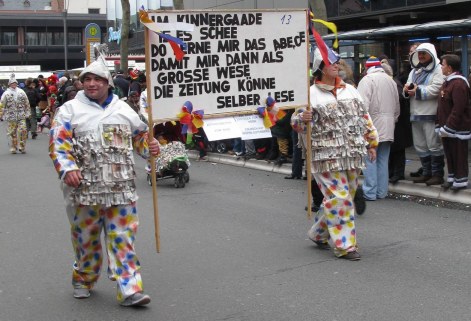
The message was further underlined that the printing press had made it possible for us to read our favourite bedtime stories and fairytales, here each child wearing a representation of one.
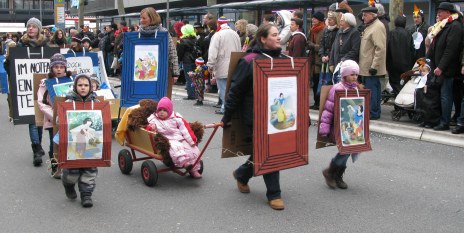
These little printers held up typesetters letters that spelled out the Mainz Fastnachts greeting (said three times in rapid succession) “HELAU”.
Some wore placards with their own favourite printed words – enhanced by some original drawings.
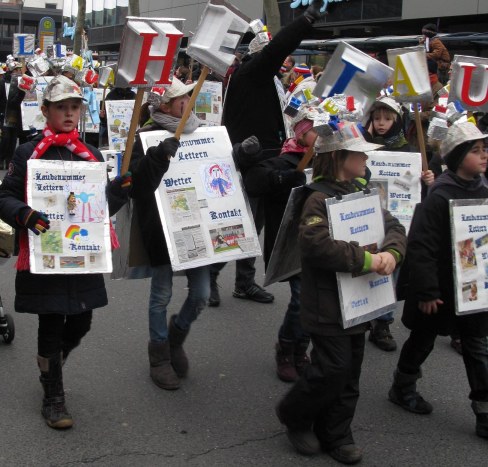
There were print allusions aplenty, from letters themselves…
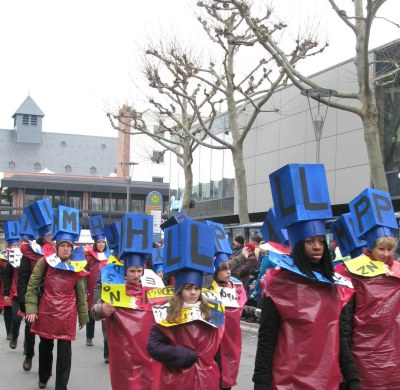
…festive books…
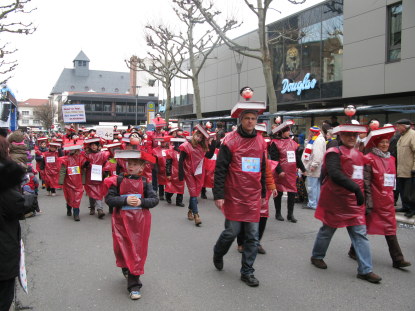
…and of course printing à la Gutenberg was not just about the written word – but about pictures as well.
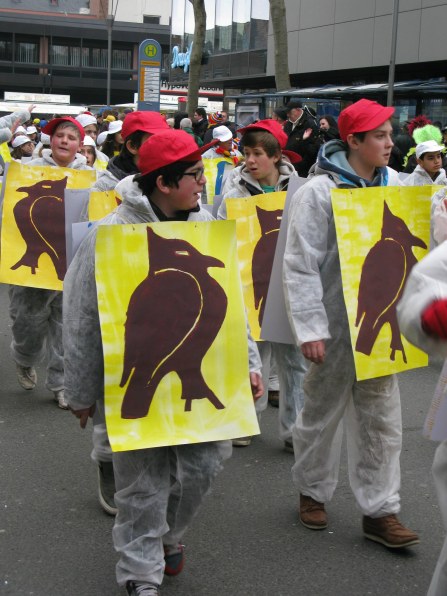
Ponies and pretzels at the children's carnival parade in Mainz
In between the gathered marchers of the children's carnival parade came a string of ponies…cardboard replicas being much safer for very small people.
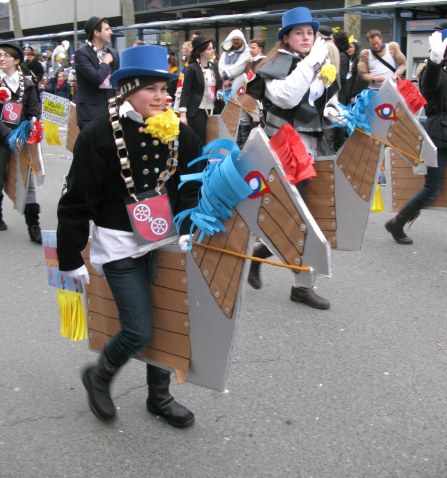
As the children's parade passed in a leisurely fashion, the Pretzel Man was a welcome supplier to hungry stomachs.
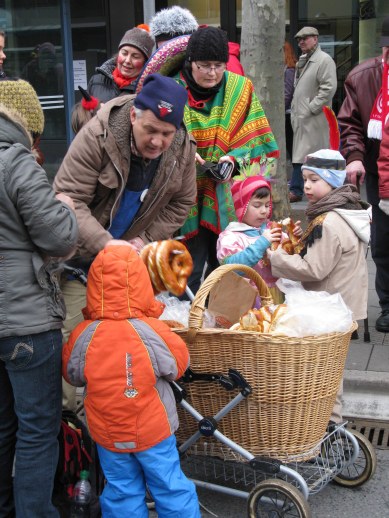
Mainz Carnival cadet corps to the Carnival Gardes
All this was happily mixed with cadet corps of the various carnival associations.
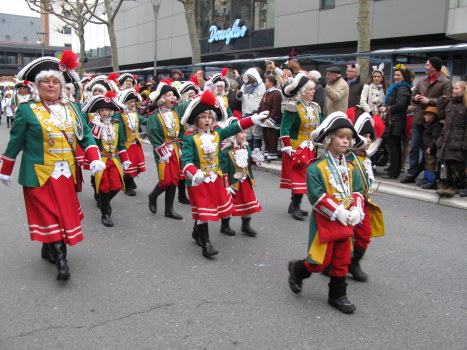
The youngsters wear exact replicas of the adult corps members uniforms – with all their silver braid, lace and fluffy feathers.
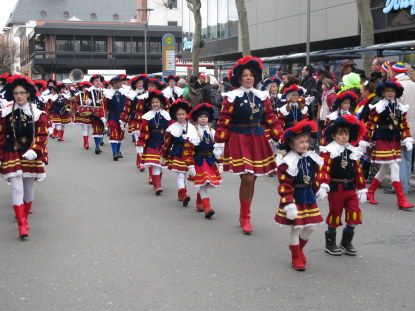
It must be captivating to play 'dress-up' in the cadet corps costumes.
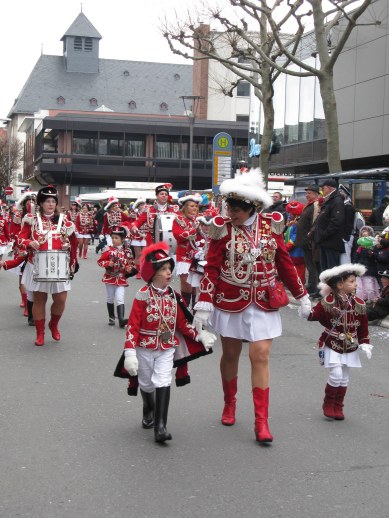
To be or not to be - part of the Mainz children's carnival
But one of the lovely things about the Mainz Children’s Carnival Parade is that it is optional.
Just as some adults are allergic to dressing up and being silly during Carnival Season, so too are some smaller people.
My doctor told me that her son was happy to help with the school’s costumes but didn’t want to be in the parade itself.
I reflected back to my English tradition of schooling, where inclusion in school events was definitely NOT optional - and not for the first time was glad I lived here, where people are seen as individuals, even at a young age.
No message: just good fun - costumes at the Mainz children's carnival parade
Of course not everything had a story to tell and some costumes were just plain fun.
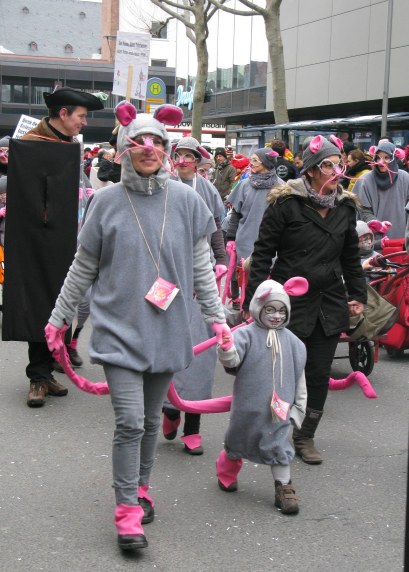
… like the school of mice…
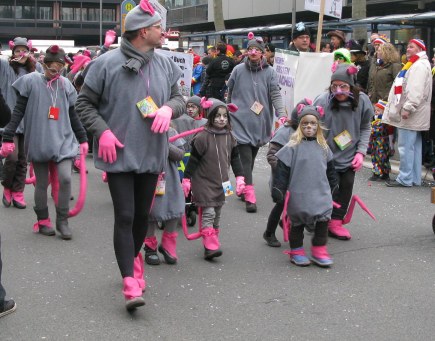
…or this little train of pedal cars with costumed drivers.
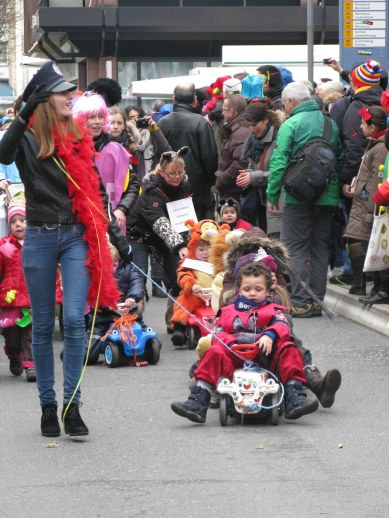
Mainz children's carnival parade bands
As with all parades in Mainz, in the children's parade there is a generous inclusion of bands.
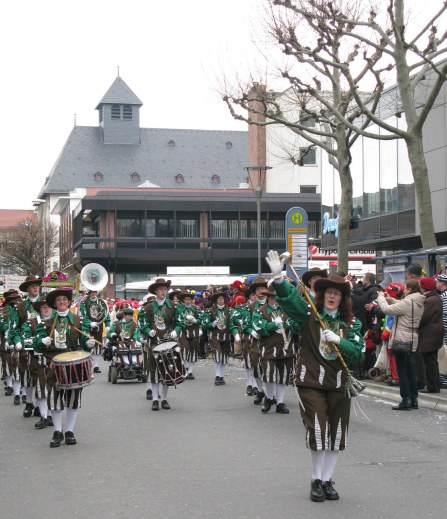
...those of the traditional carnival associations…
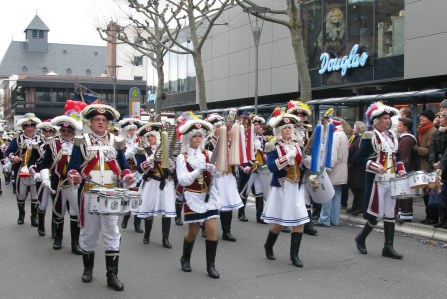
…and a wide variety of colourful others …
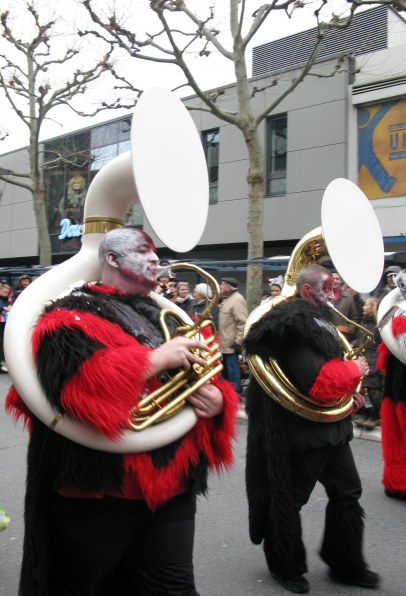
….including the greatly danceable, catchy and slightly off-melody tunes of Guggemusik.
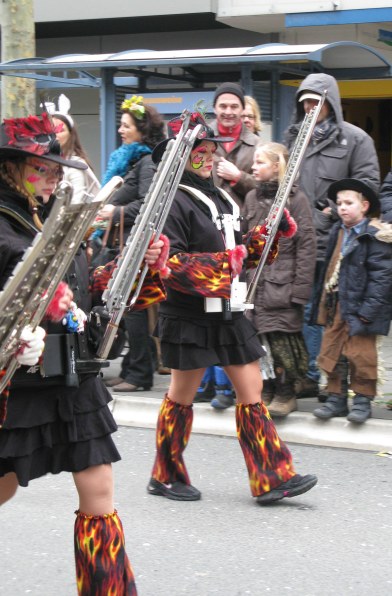
Children's parade floats in Mainz
There were a few floats…
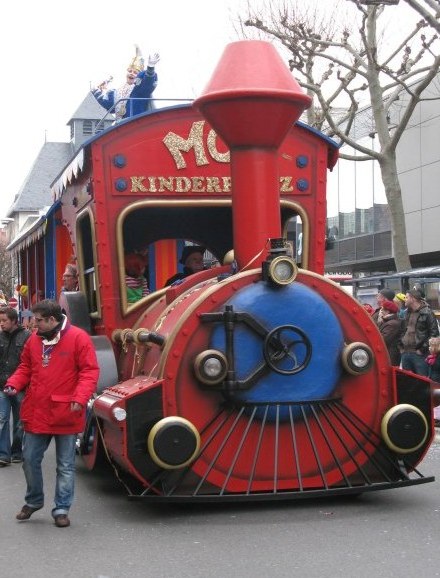
… with candies being thrown …
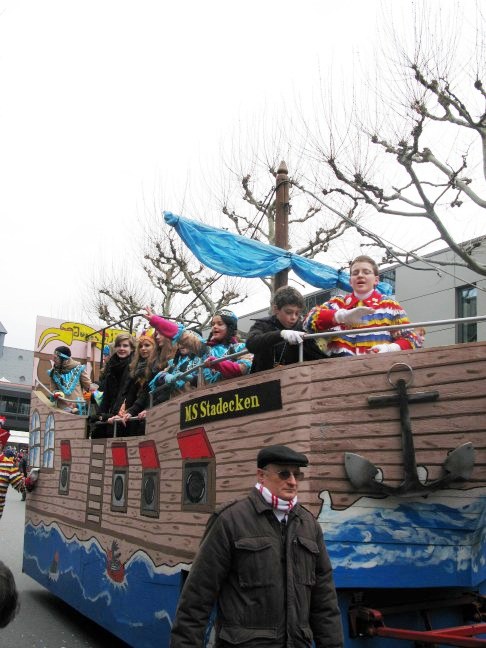
…for waiting little costumed-scavengers to stuff into their carry bags.
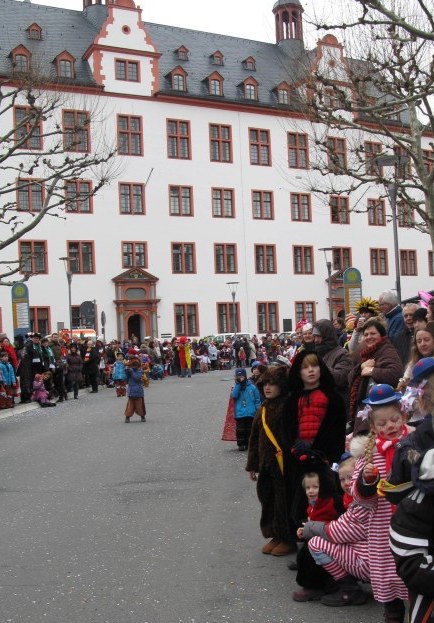
The modern Gutenbergs of the www
The Gutenberg heritage was carried to its logical conclusion by adaptation to the modern 'printing press' – that of the Worldwide Web - with a parody of both Twitter and Facebook, the latter trailing a long list of hundreds of 'friends'.
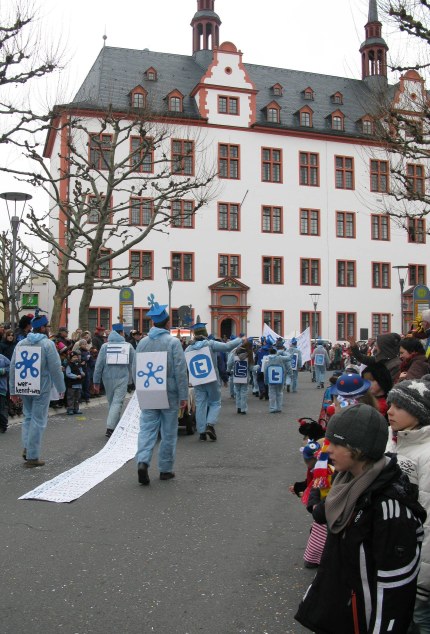
With a theme of communication, the children's carnival parade wouldn’t be a completely modern picture without reference to tablets.
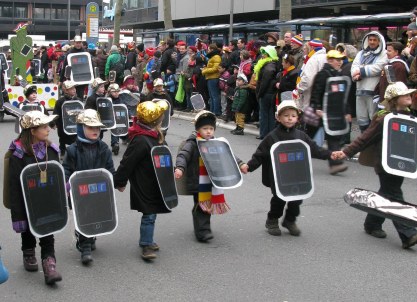
These little iPads were holding hands.
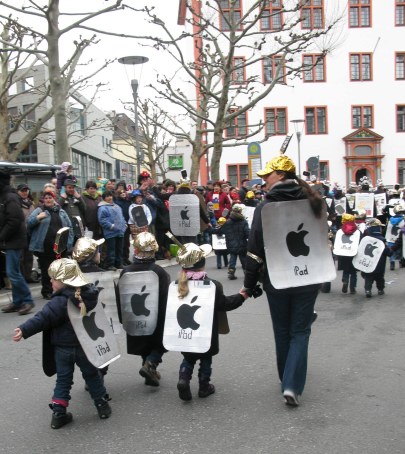
Such a parade also would be incomplete without Smartphones, especially the 'Ei' Phone (’EI’ meaning ‘egg’, in German).
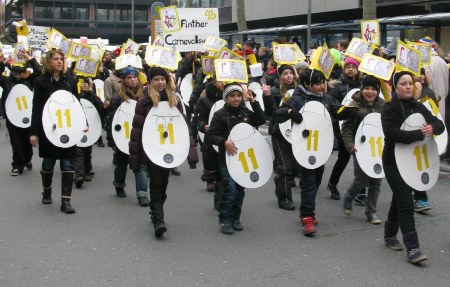
One wonders if its general lust for life and enthusiasm for celebrations is not an integral part of the reason why Mainz continues to be a favourite location for innovative businesses.
Mainz - a creative city
The characteristics of Creative Cities have been controversially but thoroughly documented by the studies of Richard Florida, in The Rise of the Creative Class: And How it's Transforming Work, Leisure, Community and Everyday Life .
The original study had a US focus that has since been expanded globally. The concepts of developing things more creatively has been applied by his group to development plans for communities as well as to commercial enterprises.
Coming from the profession of Economic Development, it is not surprising to me that Mainz continues to attract good researchers and to be a hub of innovative business that breaches former boundaries.
Apart from anything else, the link between music and science has also been well documented, and here the children grow up in a musical environment, starting very young. Every Geramn child must learn a musical instrument in school - a fine grounding for a country where engineering is a much respected profesion.
Music and young people in Germany
These youngsters in the chidren's carnival parade straggled enthusiastically along the parade route, chatting with their classmates, musical instruments dragged along, or shouldered unceremoniously.
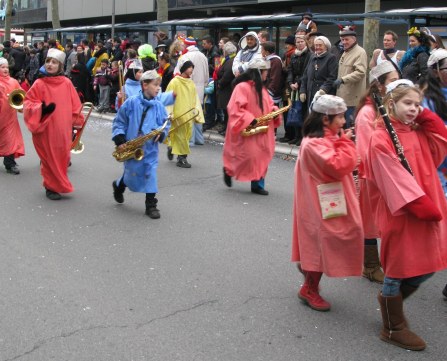
That is until the moment of playing them, when to a person, they instantly, and with equal enthusiasm, fell into deep concentration.
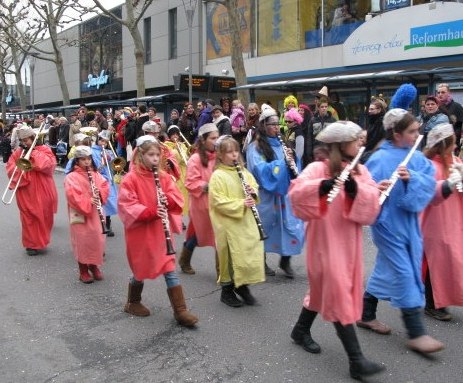
The valuing of knowledge is not limited to a University education.
In Germany there is still a valued tradition of apprenticeships.
The highly respected Master Carpenters give some aspiration to young minds in their traditional black broad-brimmed ('Stovepipe') hats, black waistcoat and bell-bottom trousers .
The history of the Journeymen
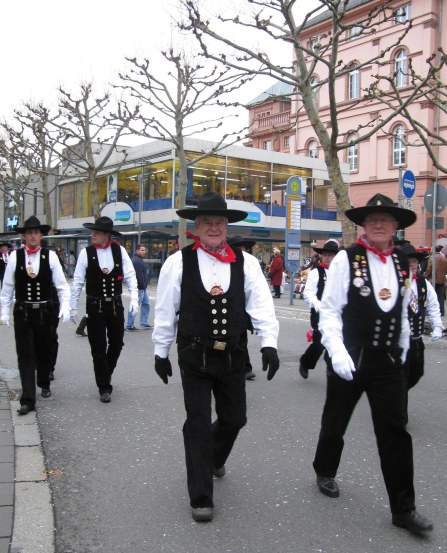
The old medieval tradition of being a 'Journeyman' is still practiced throughout Germany. Many think this only holds for the carpenters, but this is only due to them being more widely visible from their traditional 'Waltz' costume.
The tradition has had a resurgence after being banned by the Nazis.
Traditionally, the work of an apprentice could not be charged. He lived with the family of the master. On completion of his apprenticeship he was unable to be awarded a 'Guild' of his own, being considered yet inexperienced. Instead he was given a 'Wanderbuch' - a travelling logbook - and was then considered 'auf der Walz sein' or 'to be on the waltz' - or what we would call a 'journeyman'.
The journeymen carry their few goods in a very small cloth roll and travel with a traditional hefty wooden curled stock. The well-known Australian song 'Waltzing Matilda' which tells the life of a 'Swagman' ( carrying his goods & bed rolled together in a ‘swag’) harks back to this long tradition.
The journeyman period of travel is either three and a half years and a day - or two and a half years and a day.
During this period the graduated apprentice cannot take public transportation between towns. He leaves with what used to be 5 Marks, now 5 euros, and must return with the same amount – demonstrating that he has not lost money and not gathered money, but has used his time to learn and travel.
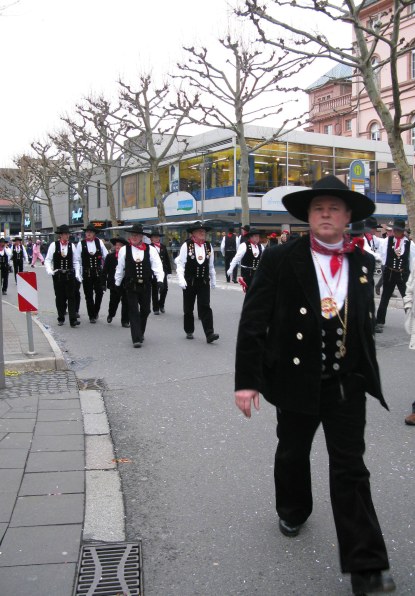
If the journeyman stays with a friend or family or girlfriend and doesn’t stay true to the rules, he forfeits all his training credentials.
He can’t return within 50 kilometres of his hometown during the period (except for severe illness or death of a family member).
In each new town he must present his Wanderbuch for a stamp of that town. This replaces the need to register, which is mandatory in every German city. This registration requirement pertains to allocation of funds from the state to the city for public services and is not a symbol of extreme control and tracking of who is where, as is sometimes suggested.
These old Wanderbücher form a great traceable history of how wide these travels have been over the ages.
The idea is that the journeyman will go from one Master Carpenter establishment to another, gaining experience on the way and working in return for his sustenance and board.
I first came across the journeyman tradition in a favourite small Mainz restaurant before I spoke the language. My dinner companion was from Hamburg and explained the tradition to me as the aspiring Master made a quiet request of the waitress, who then went and asked the owner.
Having been granted permission to do so, the journeyman then thumped his stock (a hefty walking stick) three times on the wooden floor.
With everyone’s attention thus secured, the journeyman recited a long verse and then made the rounds for a collection before departing.
My dinner companion explained that hotels and guest houses usually let them stay for free and restaurants often provide them food as well.
I have always had immense respect for this tradition ever since. It certainly weeds out the men from the boys. When a man lives from his wits, and has completed his Waltz, breaking none of the rules, he is granted his Guild.
Being no longer a journeyman, he has ever after the respect of being a true Master - and along the way has no doubt had time enough to observe both mankind and also nature, see its wonder, and perhaps even to become a bit philosophical.
As Bertrand Russell said:
The world is full of magical things
patiently waiting for our wits to grow sharper.
Mainz children's paarde political heads
The Mainz Carnival Children’s Parade ends with the political ‘heads’…the caricatures of local politicians that you would think would be scary to little people, but they are such a familiar sight that they are greeted with enthusiasm.
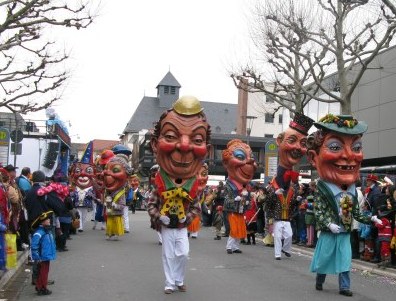
Mainz children's paarde - a family affair
At the end of the parade, families retire to the fun fare that is held in the shadow of the Dom, or Cathedral, in the market square.
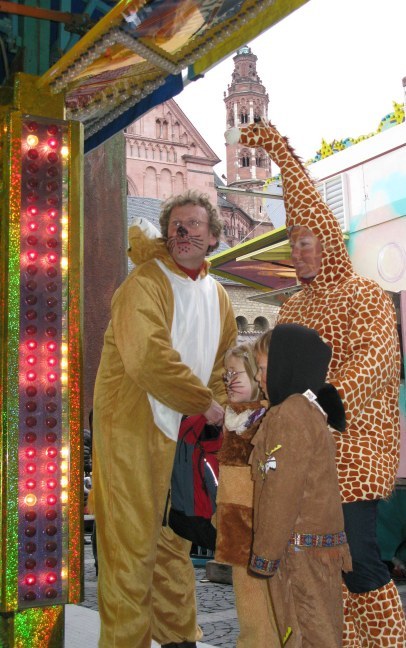
Here, the rides are full of little costumed people, watched over by big costumed people.
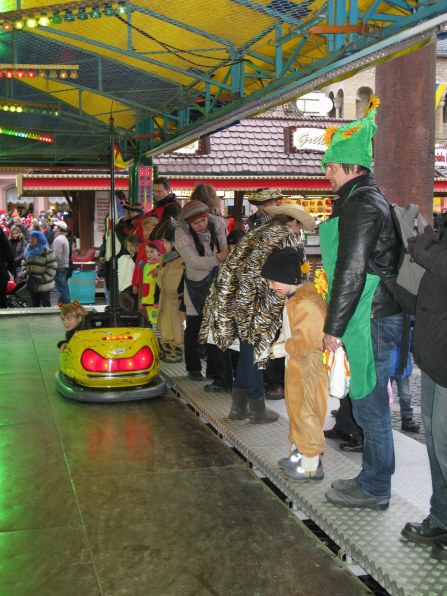
The Mainz Children's Carnival Parade demonstrates something Friedrich Nietzsche said:
In every real man is hidden a child who wants to play
